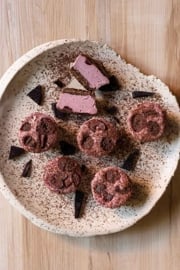
Don’t throw away those apples that are spongy and past their prime or the peels and cores from making your favourite apple dishes! You can quickly give these castoffs new life as delicious and nutritious apple vinegar. With minimal effort and a minor time and cost investment, the simple process provides delicious, health-building vinegar in a couple of weeks.
You’ll notice there is sugar in this recipe. It acts as a natural preservative so the apples don’t just rot, and it provides food to encourage the growth of probiotic cultures. Apples aren’t high in natural sugars, so without the added sugar, they would just grow mold and other unwanted microbes. But don’t worry: the beneficial bacteria eat most of the sugar, causing them to multiply as they go. The result: high quantities of beneficial, health-building bacteria.
Apple Vinegar
Ingredients
- 1/2 cup (125 mL) coconut sugar
- 1 quart (1 L) filtered water
- 4 apples, cores and skins included
Directions
01
In a pitcher or large measuring cup, mix together the sugar and water, stirring if necessary to encourage the sugar to dissolve.
02
Chop the apples into quarters, and then chop each piece in half. Place the apple pieces, cores and skins included, in a 1 to 2 quart (1 to 2 L) jar or crock, leaving about 1 to 2 in (2.5 to 5 cm) at the top of the jar.
03
Pour the sugar-water solution over the apples, leaving about 3/4 in (2 cm) at the top of the jar. The apples will float to the top, and some wonu2019t be submerged, but thatu2019s okay.
04
Cover the opening with a few layers of clean cheesecloth, and attach an elastic band around the mouth of the jar or crock to hold the cheesecloth in place.
05
Every day, remove the cheesecloth, and stir to cover the apples with the sugar-water solution, re-covering with the cheesecloth when youu2019re done. You must do this every day to ensure that the apples donu2019t go moldy during the fermentation process.
06
After two weeks, strain off the apples, reserving the liquid; you can add the apples to your compost. Pour the liquid into a bottle, and seal with a tight-fitting lid or cork. The vinegar keeps for approximately one year.





